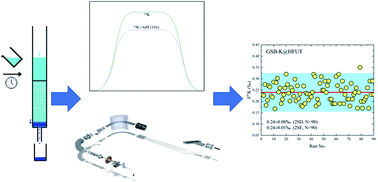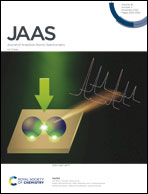High-precision analysis of potassium isotopes by MC-ICP-MS without collision cell using cool plasma technique in low-resolution mode†
Abstract
This study presents a method for high-precision stable potassium (K) isotope analysis using multi-collector inductively coupled plasma mass spectrometry (MC-ICP-MS) without a collision cell in low-resolution mode. The cold plasma technique (RF power of ∼600 W) combined with wet plasma was used to suppress the formation of argon hydrides, which are direct isobaric interference to K ions. The remaining ArH+ interference was deducted by measurements from the blank acid before and after each measurement. Using this analytical method, precision of better than 0.08‰ (2SD) for 41K/39K could be achieved based on routine measurements of pure K solution during a six-month period. The effects of matrix elements, acid strength, ArH+ percentage and concentration mismatch on the precision of the K isotope measurement were also evaluated. Mismatches in K concentration (up to 20%) between samples and bracketing standards did not affect the precision and accuracy significantly, whereas the precision and accuracy were very sensitive to mismatches in acid molarity. Thus, the same batch of acid is needed to dissolve samples and bracketing standards. The measured potassium isotopic compositions of international rock standards using the present method agreed well, within analytical precisions, with previously reported values. We believe that this contribution will accelerate the output efficiency of K isotope data and motivate the use of potassium isotopes as potential tracers in geosciences.



 Please wait while we load your content...
Please wait while we load your content...